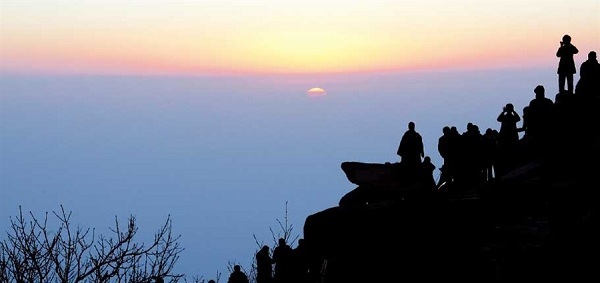Taishan: From where the world looks small
 0 Comment(s)
0 Comment(s) Print
Print E-mail Shanghai Daily, June 1, 2017
E-mail Shanghai Daily, June 1, 2017
|
|
|
People throng to the Jade Emperor Peak for the magnificent sunrise. (Wang Rongjiang) |
Taishan, or Mount Tai, is one of China's most sacred mountains. For centuries, emperors climbed it to pay homage to Heaven and Earth. Philosopher Confucius is said to have stood at the towering top, looked down and pronounced the world a small place indeed.
It is known as the "Eastern Mountain," or dong yue, of the Five Great Mountains of China — the other four being Mount Hua (Shaanxi Province), Mount Heng (Hunan Province), Mount Song (Henan Province) and Mount Heng (Shanxi Province). In 1987, Taishan was named a UNESCO World Heritage Site.
While it isn't China's tallest mountain standing at 1,545 meters above sea level, the way to the top is still a challenge consisting of more than 6,000 stone steps, with the option of taking a cable car halfway. Walking the whole way can take anywhere from three to seven hours.
I'd heard stories about elderly groups and others resolutely marching up the mountain in the dark and arriving in time to see the sunrise, but I decided, with some friends, to start in the afternoon and see the sunrise after spending the night in a hotel at the top.
We entered through the Red Gate at the south foot of the mountain, stopping to look in temples with burning incense and at some of the hundreds of stone tablets that dot the way up. We were surrounded by serene greenery, punctuated every so often by a rousing round of pop music from tourists carrying personal stereo systems for all to hear.
Two 7- and 9-year-old brothers offered me a welcome excuse to rest from climbing when they asked "auntie," one of the few foreigners on the mountain, to pose for a photo with them.
Then I continued to follow in the footsteps of the emperors. In 219 BC, Emperor Qinshihuang, founder of the Qin Dynasty (221-207 BC), held a ceremony on the summit to announce to the gods that he had successfully unified China.
For thousands of years, Mount Tai has been a source of inspiration for poets and thinkers, and a place to worship. It is the most venerated of China's five sacred mountains. This is because it is the easternmost, and in Chinese culture east is regarded as a sacred direction because that is where the sun and moon rise.
Confucius, whose hometown Qufu is not too far away from the mountain, declared from the summit: "Climb Mount Tai and the whole world looks small." His words express how Mount Tai looks large against its low-lying surroundings, and also the more philosophical musing that the higher you climb, the greater your vision.
For me, the higher I climbed, the more steps I saw, until finally I got to the steps leading up to the cable car station. Of course, Confucius wouldn't have taken the cable car, but I wasn't Confucius. And two hours of climbing steps was enough of a climbing experience for me.
On top of the 1,545-meter mountain, lodging is limited. There are a few basic hotels, and travelers also come equipped with camping gear. We stayed in a hotel and paid 100 yuan (US$15) per person to sleep on mattresses in a room with 13 people. Outside our door, other guests slept in tents or rows of beds lining the corridors.
Another likely difference between my experience and that of Confucius: He probably didn't climb the mountain at the same time as thousands of other people.
In the morning, we got up at 4am to position ourselves for the sunrise, apparently peak time on the mountain.
From Jade Emperor Peak, or Yuhuang Feng, sitting among hundreds of others, many in rented green army overcoats to keep warm against the strong wind, we were fortunate enough to see a clear sunrise, majestically bathing the mountain peaks in light.
After a breakfast of soybean milk and fried dough sticks, we hiked for about five hours down the mountain and through Taohua Yu, or Peach Blossom Valley, a beautiful walk through pine trees and flowering peach trees, waterfalls and pools of water, not unlike a landscape you might expect to find in central Europe.
Despite the many people, our weekend trip to Taishan was a relaxing and energizing experience. The greenery up the mountain made for a picturesque climb, and the second-day valley hike was to me the highlight, and not just because there were no steps up.
It was serene, allowing me to enjoy the landscape and contemplate the greater vision I had gleaned from the top of Mount Tai.
How to get there: High-speed trains run to Tai'an city, Shandong Province, from Shanghai (four hours), Beijing (two hours) or Ji'nan, capital of Shandong (30 minutes). Then take a bus or a taxi to one of the four entrances, including Red Gate and Peace Blossom Valley. From the Peace Blossom Valley entrance you can also take a tourist bus (30 yuan one way) to the cable car station. Cable car is 100 yuan one way.
Admission: February-November, 125 yuan for adults, 60 yuan for children; December-January, 100 yuan for adults, 50 yuan for children
Where to stay: Xianju Hotel, at the top of Mount Tai, near the South Heaven Gate. Standard rooms from 400 yuan.






